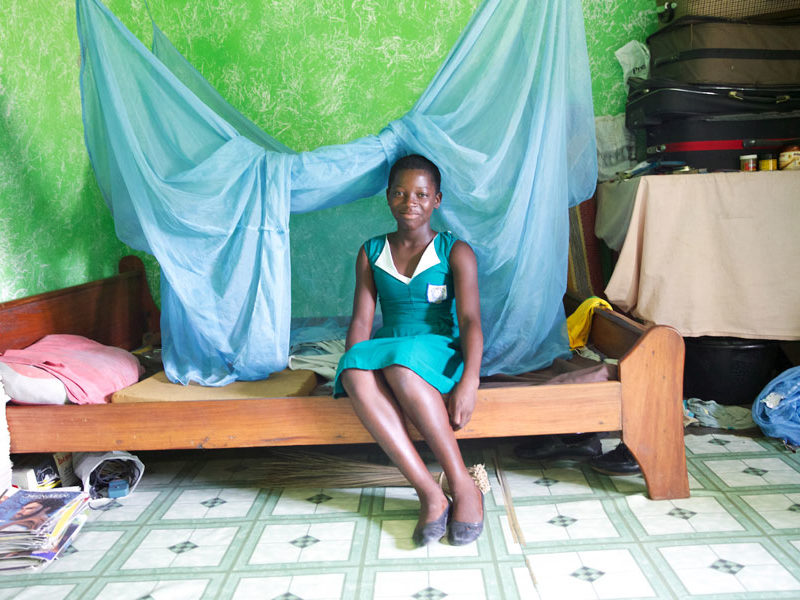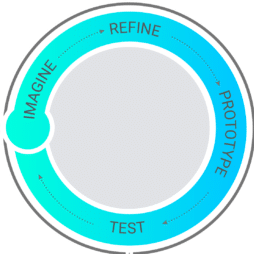

Human-Centered Design (HCD) is a framework or mindset for solving problems that emphasizes the human perspective in order to create the best possible results. It is not a top-down approach, but rather a collaborative process experienced together with the very people who will benefit from whatever innovation or tool is being developed.
The design-thinking process, as facilitated by the Johns Hopkins Center for Communication Programs, can help practitioners leverage their creativity to achieve novel solutions to complex problems, most often in the public health space. The design thinking process includes five distinct, yet interconnected, steps — empathize, define, ideate (brainstorm), prototype, and test.
Click on the steps below to learn more.
The Social and Behavior Change Flow Chart is CCP’s design process for social and behavior change activities to address health or development challenges. The SBC Flow Chart comprises three phases, Define, Design and Test, and Apply. This integrated approach draws on design, behavioral science, community engagement, market research and communication, and brings together the strengths of each discipline, methodology and technique to create new opportunities for innovative SBC solutions.
A major barrier to overcoming the challenges of addiction and overdose in Baltimore City and the Johns Hopkins Health System is stigma, or labeling, stereotyping and discrimination. One example is using disparaging or judgmental terms to refer to addiction, people with substance use disorder, or treatments for the disease.
CCP led a hackathon where four different ideas were fleshed out for a campaign to reduce opioid use disorder stigma among in a number of types of health care providers. The concept of “Words Matter” was chosen and tested. Today, the campaign is live on Johns Hopkins Medicine’s website, where providers can learn about what they say and do matters to patients with substance use disorder, and also take the Words Matter Pledge.
Many in South Sudan lack access to latrines, with an estimated 60 percent of people practicing open defecation. The current method of trying to change this behavior uses shame as its central theme. While shame can be a motivator for change, for some individuals it serves an opposite purpose and becomes a barrier.
CCP led an HCD process in Juba with stakeholders, where participants discovered insights and developed community-based solutions for maximizing the uptake and use of latrines without utilizing shame. After testing and refinement, CCP helped create the Model Home Program, which publicly identifies households in a community who own a latrine and are part of a program to keep their latrine clean, or homes who commit to building a latrine, by displaying a flag as part of the program. Model Homes are recognized in the community and by community leaders.
The flow of the most up-to-date, relevant family planning and reproductive health information among global programs, countries and regions is fragmented. CCP wanted to ensure more family planning professionals around the world had access to evidence and best practices to optimize their programs so that more women receive the services they need and deserve.
The CCP-led Knowledge SUCCESS held regional, virtual workshops with family planning professionals from across Africa, Asia and North America. Three new knowledge-sharing programs were designed.
These include FP insight, a user-driven curation platform inspired by Pinterest to create a body of knowledge for the whole professional community; Learning Circles, interactive, small group discussions about what works in program implementation; and The Pitch, a competition that has already provided $600,000 to start or scale knowledge management initiatives in Africa and Asia.
Phase 1: Define

Phase 2: Design & Test

Phase 3: Apply

Receive the latest news and updates, tools, events and job postings in your inbox every month
Determine the stakeholders involved in the challenge of focus and learn about them.
In design thinking, the testing phase is done early and frequently, and the feedback received on the prototype is fed back into the design thinking process at whichever phase is most relevant.
Clarify and further define the challenge of focus.
During this phase, the design team is tasked with performing an analysis of the landscape of the challenge, which includes identifying the positives, challenges and opportunities related to it, and ultimately identifying key insights that will serve as the basis for ideation.
Brainstorm solutions for the identified challenge, rooted in a deep understanding of the end user(s) and related stakeholders.
During this phase, the design team is tasked with using the data collected during the empathize and define phases to brainstorm creative, human-centered solutions for the challenge.
Create a rough draft model of the selected solution.
During this phase, the design team is tasked with selecting the top idea(s) from ideation/brainstorming to prototype. In design thinking, we emphasize prototypes, or rough draft models, as that helps facilitate honest and useful feedback from users during the testing phase.
Receive feedback on the prototype(s).
In design thinking, the testing phase is done early and frequently, and the feedback received on the prototype is fed back into the design thinking process at whichever phase is most relevant.